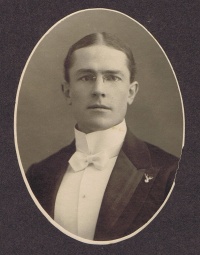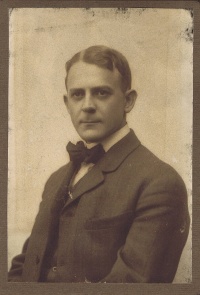Members of the Orlando Brown family lived at 202 Wilkinson Street (now referred to as the Orlando Brown House) for 120 years. The first residents were Orlando Brown Sr. and Mary Watts Brown. Three generations of family members lived in the home. The Browns became writers, owned businesses, served their country in wars and as civil servants, and worked in their community. None of the third generation of Browns had children and the last resident of the Orlando Brown House, Annie Hord Brown, died in 1955. There are no living descendants in the Orlando Brown family line.
First Generation: Orlando Brown Sr. and Mary Watts Brown
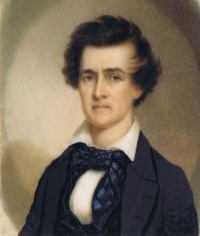
John and Margaretta’s second son, Orlando Brown (1801-1867), was born in Frankfort. In 1809, an eight-year-old Orlando went to a school ran by a man named Mr. Holroyd. By 1818, his father sent him to Danville, Kentucky to study with Mr. Kean O’Hara to learn “Geography & Algebra & six books of Euclid.” Like his father, Orlando attended Princeton University and graduated in 1820. Much to his parents’ dismay, Orlando was unindustrious and casual about his future plans, saying that is “old enemy indolence” would make him a bad lawyer and that the thought of “amputated limbs and women in labor” put him off being a doctor. In a letter to her son, Margaretta demanded a serious response about his choice of career, “I am sorry, my dear Orlando, to find you treat the subject of choosing a Profession with so much levity-It is certainly one which deserves serious consideration…”
Orlando’s career path was not as straight has his brother Mason’s. He studied medicine for a time with John Brown’s brother, Dr. Preston Brown, and not finding that to his liking, he attended Transylvania University and received a law degree in 1823. For three years, Brown practiced law in Tuscumbia, Alabama.
Orlando finally settled on a writing career. He had written poems and prose as a young man and his mother, a poet herself, encouraged his writing. In an 1819 letter, Margaretta writes, “I was most pleased with the extracts which you sent me from your ‘composition book’…Do not neglect to send me further ‘extracts’ they will always interest me, for though I am attached to poetry… I am alive to the beauties of prose- Cultivate them…since nature has enabled you to express your thought fluently in prose.
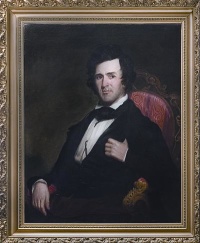
He co-founded the Commonwealth, a Frankfort newspaper, with A.G. Hodges and served as its editor for nine years. The paper was supportive of the Whig Party, of which Orlando was a member. He ran the paper with integrity and consistency. He acquired the nickname, “The Old Master,” as he never attempted to write upon a subject until he had mastered it. In addition to editorials, Brown wrote local and state historical articles that appeared in the Commonwealth. In 1840, he edited The Campaign, a short-lived newspaper that was a platform for the Whig Party. Late in his life, he began writing a history of Kentucky’s governors; however, this work was unfinished at his death in 1867.
Orlando was praised for his writing. In 1862, Hodges wrote, that he was “…known throughout the Commonwealth as…among the very ablest of our political and literary writers.” Washington Irving, author of The Legend of Sleepy Hollow, after being sent issues of the Commonwealth, was so charmed by Orlando’s writing that he wrote a friend: “… a man who could write in that manner ought not to be connected with a newspaper, but ought to instruct and delight his age [through] books.”
In 1828, while still in Tuscumbia, Orlando’s law partner died, causing him to think about returning to Frankfort. Orlando’s main reason for returning to Frankfort, which he did in 1829, was because he was lovesick. Prior to moving to Alabama, Orlando had fallen in love with his first cousin, Mary Watts Brown (1808-1841), the daughter of his Uncle Dr. Preston Brown and Elizabeth Watts Brown. Mary was seven years Orlando's junior and was just sixteen when Orlando began courting her. She did not immediately return his affections. While in Alabama, Orlando wrote poems about his misery, one line from a poem from this time read: “My bosom is with anguish torn – Yes Mary! my poor heart is broken.” Orlando remained steadfast in his love for Mary, and they married in 1830.
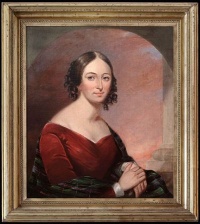
The pairing was likely approved by Orlando’s parents. Mary Watts had been one of Margaretta’s pupils at her Sunday school in Frankfort. Margaretta boasts about her in a letter to Orlando writing, “she has committed 690 [hymn] verses to memory” and “has memorized (scriptures – hymns and catechisms) 2387 verses.” Margaretta goes on to confide that Mary “is …much the finest girl, of the three” referring to Mary, and her two sisters.
Orlando and Mary lived in a Greek Revival home designed by Kentucky architect, Gideon Shryock. The home, now referred to as the Orlando Brown House, is situated on a lot to the left of Liberty Hall. John Brown had the home built for Orlando and Mary to split up his children’s inheritance. The eldest son Mason would inherit Liberty Hall.
Mary and Orlando had five children, three of those children survived to adulthood. Euphemia, Mason Preston, and Orlando Jr. Their son John Preston Brown (1834-1835) died as a nine-month-old infant and Mary suffered a stillbirth in 1840. After the stillbirth, Mary’s health suffered and she died in 1841 on route to Blue Sulfur Springs, Virginia (in present day Greenbrier County, West Virginia) to “take the waters.”
Devasted by her death, Orlando wrote about his wife in a letter to his young children shortly after she passed. He described her physical beauty and lovely personality writing, “No one was ever more graceful – none could exceed the sweetness of her behavior and there was a uniformity of politeness and gentleness, that made her dear to all who knew her.” An accomplished piano player and singer, Orlando wrote that “Her voice was clear & sweet without being very powerful and her singing found its way to every heart and will long live in the memory of her acquaintances.”
In 1852, eleven years after Mary’s death, Orlando remarried. His second wife, Mary Cordelia Brodhead (1810-1874), was the widow of Orlando’s friend Lucas Brodhead. The couple had no children together, however she had six children from her first marriage. They raised all of their children at the Orlando Brown House.
Orlando served on the Board of Internal Improvements for the State of Kentucky in 1835 and one of his first projects was improving navigation on the Kentucky River. He was also elected the first corresponding secretary for the Kentucky Historical Society in 1836. In 1848, he was appointed Kentucky’s Secretary of State under Governor John J. Crittenden, who was one of his good friends. In 1849, Orlando became the Commissioner of Indian Affairs in President Zachary Taylor’s administration. Unhappy in the position and disliking Washington, he resigned in 1850.
Orlando was an ardent supporter of the Union and the Constitution. It is not surprising, then, that in 1862, during the U.S. Civil War, Orlando resumed as editor of The Frankfort Commonwealth for seven months. The paper favored the preservation of the Union. Orlando was also awarded the rank of Colonel during the Civil War for his service as a recruitment officer.
While he was pro-Union and at first supported President Lincoln, he did not support the Emancipation Proclamation of 1863. He felt that the power to emancipate enslaved Black people should be left to the states. A defender of slavery, Orlando Brown enslaved twenty people in 1850. He wrote in the Commonwealth in 1835 that slavery in Kentucky was “nothing more than a mild form of vassalage.” He disagreed strongly with Abolitionists and likely did not free his slaves until the passage of the 13th Amendment. He wrote to his son Orlando Jr. in a letter, “I am daily looking for the authentic announcement of the adoption of the Amendment. When it comes, I will let our Servants know that they are free. What they intend to do and what we intend to do is equally unknown.”
Second Generation: Euphemia, Mason Preston, and Orlando Jr.
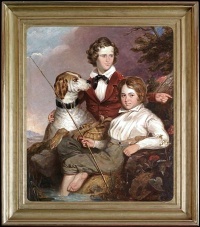
Euphemia Helen Brown (1831-1891), the first child and only daughter of Orlando and Mary Watts, was likely named after Orlando’s sister Euphemia. As an infant, she was dangerously ill with scarlet fever and this may have caused brain damage. Letters written by family members note that she did not talk until age three and when she finally did speak, her grandfather John Brown described her as “…a great talker but in Cherokee or some dialect peculiarly her own.” By the time she was eight years old, Euphemia was said to have a sweet temper and Orlando remarked that “Of her mental qualities I can only say that she is now more intelligent than I at one time thought she would ever be.” He went on to say that, “Her memory is excellent but her judgment is defective” and “her development…tardy.” She was educated at a school with a Mrs. Price in 1839. Perhaps her condition worsened after her mother died in 1841 or her father was unable to take care of her properly, because by 1858 she was under the care of Archbishop John Baptist Purcell at a Catholic hospital in Cincinnati. Purcell wrote to Orlando that she was very quiet and amiable but suffered “mental aberration and strange fancies.” Euphemia appears in the 1860 census, living back in Frankfort, but by the 1880s and up until her death in 1891, she lived at St. Elizabeth Hospital in Covington, a hospital that served the sick, orphans, and the elderly. She spent much of her life institutionalized.
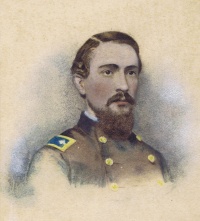
Mason Preston Brown I (1836-1874) was Orlando and Mary’s first son that survived to adulthood. He was frequently sick as a child and one family member noted that “[Orlando and Mary’s] anxiety about little Mason is very great—I scarcely ever hear of him that he is not sick…” As an adult, he became Kentucky’s State Treasurer serving from 1865-1867 and was Chief Clerk at the Treasury of Kentucky prior to that. He never married and died of pneumonia when he was just thirty-seven years old. Mason was said to have “been in delicate health nearly all of his days” leading a “quiet and unobtrusive life.”
Orlando Brown Jr. (1839-1891) was educated by B.B. Sayre in Frankfort and attended college at Yale University, graduating in 1858. When the Civil War broke out, he was “the first young man in Frankfort to take up arms in defense of the Union.” He volunteered as a private in the 14th Kentucky Infantry under General D. W. Lindsey and held the rank of Lieutenant Colonel. He served with this regiment during the Big Sandy campaign under General Garfield but resigned in 1864 due to scorbutic diarrhea (scurvy), emaciation and great nervous debility.
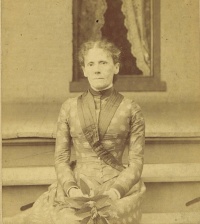
He married Elizabeth “Bettie” Hord (1841-1924), daughter of Judge Lysander Hord of Frankfort, in 1867. After marrying Bettie, the couple immediately moved to Washington D.C. because Orlando had received the appointment of Secretary of the Committee on Public Offices and Grounds. By 1870, Orlando Jr. and Bettie were back in Frankfort and Orlando and Bettie built a home on land previously owned by Orlando Sr. on the Owenton Turnpike in Franklin County. They built a Gothic Revival home and had a productive working farm on the land. After his stepmother, Mary Cordelia Brown—who was living at 202 Wilkinson St.—died and with mounting financial problems, Orlando Jr. leased the Orlando Brown House to the Dudley Institute, an Episcopal school for boys and girls from 1882-1886. Presumably, the family resumed living in the home at the end of the lease agreement.
Six children were born to Orlando and Bettie but only five lived to adulthood. A son Orlando Brown III (1870-1871) died as an infant.
Third Generation: Anne Hord Brown, Mary Watts Brown II, Lysander “Hord” Brown, Mason Preston Brown II, and Samuel Brown
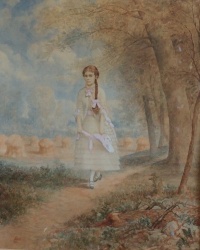
Anne Hord Brown (1867-1955) and Mary Watts Brown II (1868-1946) lived much of their lives in their family home at 202 Wilkinson St. Mary, and most likely Annie, attended school at the Dudley Institute, that for a time occupied their home on Wilkinson St. Both Annie and Mary were devout members of an Episcopal Church in Frankfort—the Church of Ascension—located on Washington St., in walking distance from their home. In 1901, Annie was the organist at First Presbyterian Church, located on Main St., also very near her home.
Mary was involved in many civic organizations including the Frankfort Woman’s Club, the Women’s Auxiliary of Ascension Church, and the King’s Daughter Hospital—she left money in her will to the church and the hospital. Mary also had a career as a stenographer at the State Capitol in the 1920s and 1930s. Mary was a lover of history and literature and many books in the Liberty Hall library collection bear her inscription. Mary was said to have a “vivid and colorful personality,” possessing a “strong character and high ideals” and was an “enthusiastic worker for any cause she endorsed.” Neither women married.
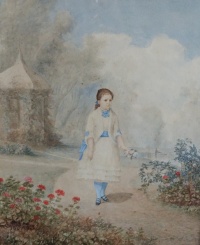
Mary and Anne were both members of The National Society of The Colonial Dames in America in The Commonwealth of Kentucky (NSCDA-KY) and they both intended for their home to be passed to the Colonial Dames at their deaths. Mary suffered an accident and became disabled in her later years, dying in 1946. The last living descendant of the Orlando Brown line, Anne Hord Brown, died in 1955 and left her home to the NSCDA-KY who still own the property.
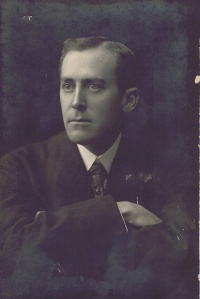
In 1892, Lysander “Hord” Brown (1871-1909), was appointed U.S. Storekeeper at the Carlisle Distillery (Franklin Co.), owned by E.H. Taylor, Jr. As a storekeeper, he was likely responsible for the physical operation of the distillery—controlling access to the grains, still, raw whiskey and bonded warehouses. In 1898, he served as a private in the Spanish-American War, having signed up with the 71st New York Volunteers. While in Cuba, he contracted yellow fever and returned to the United States. After the war, he lived in a boarding house (with his brother Sam) in New York City and was a drug store clerk. Later he worked for the Ocean Steamship Company of Savannah, generally known as the Savannah Line, which operated passenger and cargo steamships between Savannah, Georgia, and New York, New York. Due to poor health, he moved back to Frankfort in 1907 and was elected to the State Board of Equalization. He never married and died in Frankfort a few years later.
Mason Preston Brown II (1873-1941) owned the Frankfort Drugstore Company located on the ground floor of 238 West Main Street fromMason Preston Brown II, ca. 1920. LHHS Collections. 1905 until his death in 1941. He was also the vice-president of State National Bank, a charter member of the Elks Lodge and past grand commander of the Knights Templar, No. 4 from 1914-1915. Prior to entering the pharmacy business, Mason worked at Guy Barrett's bookstore on Main St., the Deposit Bank (located on St. Clair St.), and J.E.M. Milling Company. He never married. Mason lived with his sisters, Annie and Mary, in their family home until his death in 1941.
In 1898, Samuel Brown (1875-ca. 1920) served in the Spanish-American War, having signed up with the 71st New York Volunteers with his brother Hord. After the war, he lived in New York City in a boarding house (with Hord) and worked as a bookkeeper. He married Elizabeth "Bessie" Innes Brown (1882-1930) of Frankfort, Kentucky, ca. 1904 and the couple lived in Manhattan. Samuel was a cashier for a Grain, Hay, and Feed store in 1910. Bessie is listed as a widower in the 1920 census. The couple had no children.
